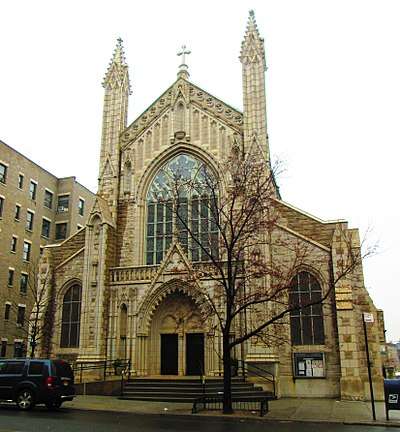Holyrood Episcopal Church
Holyrood Episcopal Church is a Protestant Episcopal Church located in the Washington Heights neighborhood in upper Manhattan, New York City.
History

The church was founded in 1893 by Rev. William Oliver Embury, who served as chaplain of the nearby House of Refuge for Problem Girls, and was operated by the Episcopal religious order, the Sisters of St. Mary, in what is now Inwood Hill Park at a time when upper Manhattan was an area of country houses located beyond the edge of the city. The congregation's first building, in country gothic style, was designed by R.D. Chandler and erected in 1895 on Broadway at what is now 181st Street. 1895, a country-style church with a tower designed by R.D. Chandler and built on upper Broadway at what is now 181st Street. The area urbanized rapidly, and in 1910 the congregation began to plan a new, larger Gothic revival building at Fort Washington Avenue and 179th Street. Designed Bannister & Schell, it was ready for occupancy in 1914.[1]
Rev. Gustav Cartensen was Rector from 1919 - 1927. He came to Holyrood after his liberal positions on issues such as permitting black children from a nearby "Negro orphan asylum" led to his resignation from the pulpit of Christ Church (Bronx, New York) at the request of members of the vestry. He was then invited to take the pulpit at Holyrood where his "liberal" positions garnered "widespread publicity," according to The New York Times.[2]
In 2017 the Church took a humanitarian position when it agreed to grant "sanctuary" to a Guatemalan refugee scheduled for deportation.[3] The woman is officially regarded as a "fugitive" by U.S. Immigration and Customs Enforcement.[3]
References
- "Holyrood Episcopal Church". nycago.org. American Guild of Organists. Retrieved 27 November 2017.
- "DR. CARSTENSEN, 90, MINISTER 65 YEARS: Rector Emeritus of Holyrood". New York Times. 27 June 1941. ProQuest 106068036.
- Robbing, Liz (18 August 2017). "Told to Go Back to Guatemala, She Sought Sanctuary Instead". New York Times. Retrieved 27 November 2017.